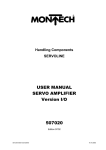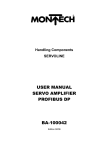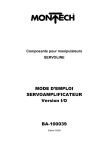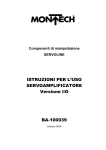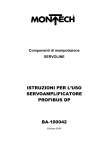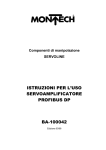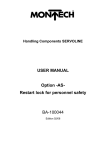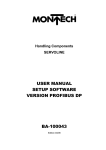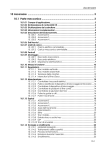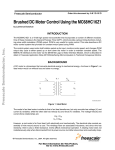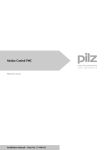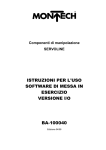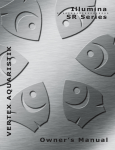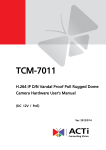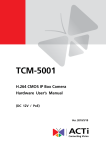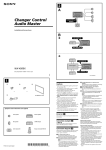Download USER MANUAL SERVO AMPLIFIER Version I/O BA
Transcript
® Handling Components SERVOLINE USER MANUAL SERVO AMPLIFIER Version I/O BA-100039 Edition 03/08 Servo Amplifier (Version I/O) Edition 03/08i Change index Editions issued so far: Edition Comments 04/01 07/02 02/06 03/08 First edition Chapter 6. Elimination of faults, new New article number New type plate Order number (English version) 507020 507020 BA-100039 BA-100039 A I Servo Amplifier (Version I/O) Edition 03/08i 1. GENERAL ..............................................................................................................1-1 1.1 Introduction 1-1 1.2 Scope of delivery of servo amplifier 1-1 1.3 Dangers and safety information 1-2 1.4 CE conformance declaration (to MRL Appendix II A) 1-3 1.5 UL and cUL conformance 1-3 1.6 Product description and application 1-4 1.7 Additional information 1-5 1.8 Validity of the User Manual 1-5 1.9 Technical data 1.9.1 Function 1.9.2 Modes 1.9.3 Dimensions 1-6 1-7 1-7 1-8 2. BEHAVIOUR OF THE SERVO AMPLIFIER ..........................................................2-9 2.1 Switch-on and switch-off behavior 2-9 2.2 Emergency stop function according EN60204 (VDE 0113) 2-10 2.3 Motor holding brake (only SVA-130 and SVE-130) 2-11 3. INSTALLATION ...................................................................................................3-12 3.1 Procedure 3-12 3.2 Assembly 3-13 3.3 Wiring 3-14 3.4 Conductor cross-sections 3-15 3.5 External fusing 3-15 3.6 Connection diagram 3-16 3.7 Connection example for multi-axis system 3-17 3.8 Connection example for master-slave system 3-18 4. INTERFACES.......................................................................................................4-19 4.1 Pin assignments 4-19 4.2 Reference switch 4-20 4.3 Voltage supply 4.3.1 Mains connection (X0) 4.3.2 24V auxiliary supply (X4) 4-20 4-20 4-20 4.4 4-21 Motor connection (X9) 4.5 Feedback 4.5.1 Resolver connection (X2) 4.5.2 Encoder (X1) 4-22 4-22 4-23 4.6 Control signals 4-24 4.6.1 Digital control inputs (X3) 4-24 4.6.1.1 ENABLE input ................................................................................................................ 4-24 4.6.1.2 Freely programmable digital inputs................................................................................ 4-24 4.6.2 Digital control inputs (X11A resp. B) 4-25 II Servo Amplifier (Version I/O) Edition 03/08i 4.6.2.1 Preset digital inputs........................................................................................................ 4-25 4.6.3 Digital control outputs (X3) 4-26 4.6.3.1 Ready-to-operate contact BTB/RTO.............................................................................. 4-26 4.6.3.2 Freely programmable digital outputs.............................................................................. 4-26 4.6.4 Digital control inputs (X11B) 4-27 4.6.4.1 Preset digital outputs...................................................................................................... 4-27 4.7 Encoder emulation 4.7.1 Incremental encoder interface (X5) 4.7.2 SSI interface (X5) 4-28 4-28 4-29 4.8 PC connection, RS232 interface (X6) 4-30 4.9 Interface for master-slave operation, encoder configuration (X5) 4-31 4.10 Connection to SERVOSTAR™ 600 master, 5 V level (X5) 4-31 5. LED DISPLAY......................................................................................................5-32 5.1 Structure 5-32 5.2 Error messages 5-33 5.3 Warnings 5-34 6. ELIMINATION OF FAULTS .................................................................................6-35 7. SPARE PARTS LIST ...........................................................................................7-36 8. APPENDIX ...........................................................................................................8-37 8.1 Abbreviations and acronyms 8-37 8.2 Glossary 8-38 III Servo Amplifier (Version I/O) 1. General 1.1 Introduction Edition 03/08i This Manual explains the installation, wiring and interfaces of the digital servo amplifier (version I/O). The information is broadly arranged as follows: • • • • Chapter 1: General information Chapter 2: Behaviour of the servo amplifier Chapter 3: Installation Chapter 4: Interfaces This manual forms part of the complete documentation of the SERVOLINE products. The complete documentation consists of the following documents: • • • • Description Ref. No Connection to automation systems (version I/O) Setup software (version I/O) Servo amplifier (version I/O) Mechanical design of the SERVOLINE products BA-100038 BA-100040 BA-100039 miscellaneous The documentation is available in the following language versions: German, English, French, Italian, Spanish and Swedish. 1.2 • • • • Scope of delivery of servo amplifier User manual for servo amplifier version I/O Servo amplifier SR600 I/O extension card (mounted) Counterplug X3, X4, X0A, X0B, X7, X8, X11A and X11B 1-1 Servo Amplifier (Version I/O) 1.3 Edition 03/08i Dangers and safety information The servo amplifier may be operated only in a closed switch cabinet taking into account the ambient conditions defined in "Technical Data". The servo amplifier may be operated only on the three-phase, earthed industrial network (TN network, TT network with earthed neutral). When the servo amplifier is used in the residential area, in business and commercial areas and in small companies, additional filter measures must be taken by the user. • Only properly qualified personnel are permitted to perform activities such as installation, setup and maintenance. Properly qualified persons are those who are familiar with the assembly, installation, setup and operation of the product, and who have the appropriate qualifications for their job. The qualified personnel must know and observe the following standards or guidelines: IEC 364 and CENELEC HD 384 or DIN VDE 0100 IEC report 664 or DIN VDE 0110 National accident prevention regulations or VBG4 • Servo amplifiers must not be opened. Keep all covers, protective devices and switchgear cabinet doors closed during operation. There is a danger of life-threatening or severe personal injuries or material damage. • Servo amplifiers contain electrostatically sensitive components which can be damaged by incorrect handling. Avoid contact with highly insulated materials (artificial fabrics, plastic films etc.). Place the servo amplifier on a conductive surface. • Never undo the electrical connections to the servo amplifier while it is live. There is a danger of electric arcing with damage to contacts and danger to persons. • During operation, servo amplifiers, according to their degree of enclosure protection, may have uncovered live components. Control and power connections may be live, even if the motor is not rotating. • After disconnecting the servo amplifier from the mains supply voltage, wait at least two minutes before touching any live sections of the equipment (e.g. contacts) or undoing any connections. Capacitors can still have dangerous voltages present up to five minutes after switching off the supply voltages. To be sure, measure the voltage in the DC-link circuit and wait until it has fallen to below 40V. 1-2 Servo Amplifier (Version I/O) 1.4 Edition 03/08i CE conformance declaration (to MRL Appendix II A) Conformance with the EC Directive on EMC 89/336/EEC and the Low Voltage Directive 72/23/EEC is mandatory for the supply of servo amplifiers within the European Community. The servo amplifiers have been tested by an authorized testing laboratory in a defined configuration with the system components which are described in this documentation. Determinations and standards taken into account: • EC Directive on EMC 89//336/EEC • Low Voltage Directive 73/23/EEC 1.5 UL and cUL conformance UL (cUL)-certified servo amplifiers (Underwriters Laboratories Inc.) fulfil the relevant US and Canadian standards (in this case UL 840 and UL 508C). UL (cUL) certification relates entirely to the mechanical and electrical design and construction of the servo amplifier. UL 508C describes fulfilment by the design, of minimum requirements for electrically operated power conversion equipment such as frequency converters and servo amplifiers, which is intended to eliminate the risk of fire being caused by this product. UL 840 describes the fulfillment by design of air and insulation creepage spacings for electrical equipment and printed circuit boards. Determinations and standards taken into account: • UL 508C • UL 840 Manufacturer Seidel Servo Drives GmbH Wacholderstrasse 40-42 D-40489 Düsseldorf Tel. +49(0)2 03/99 79 - 0 Fax +49(0)2 03/99 79 – 1 55 1-3 Servo Amplifier (Version I/O) 1.6 Edition 03/08i Product description and application Servo amplifiers are components of the servo axes SHA, SVA and the servo cartensian system SFP which are intended to be incorporated into industrial equipment. The digital servo amplifier is required for position-controlled operation of the servoline products SHA, SVA and SFP. Operation of the servo amplifier is through the serial interface of a personal computer (PC) running the supplied operator software. When servo amplifiers are installed in machines or plants, the intended operation of the amplifier is prohibited until it has been established that the machine or plant fulfills the requirements of the EC Directive on Machines 89/392/EEC and the EC Directive on EMC (89/336/EEC). EN 60204 and EN 292 must also be observed. In connection with the Low Voltage Directive 73/23/EEC, the harmonized standards of the EN 50178 series are applied to the amplifiers, together with EN 60439-1, EN 60146 and EN 60204. The manufacturer of the machine or plant is responsible for ensuring that they meet the limits which are required by the EMC regulations. This documentation contains advice on the correct installation for EMC, such as shielding, grounding, and the laying out of cabling. The equipment manufacturer is obliged to prepare a hazard analysis of the equipment, and is also responsible for functional, mechanical and personal safety aspects in relation to the machine. The servo amplifiers are installed as components in electrical installations or machines and may be put into operation only as integrated components of the installation. The BTB contact must be wired into the safety loop of the system. The safety loop as well as the stop and emergency stop functions must comply with the requirements of EN60204, EN292 and VDI2853. Before operating the servo axes, all work is to be carried out as specified in the operator manuals of the servo amplifier and the Servoline axes. Strictly observe all safety regulations. • Assembly, installation, wiring and final check have been carried out according to the operator manual for the servo amplifier. • Assembly, installation, wiring and final check have been carried out according to the operator manual for the servo axes. 1-4 Servo Amplifier (Version I/O) 1.7 Edition 03/08 Additional information The aim of the present User Manual is to enable users to employ the servo amplifier correctly and safely. Should further information be required in relation to your particular application, please contact the manufacturer. When reordering User Manuals, it is essential to quote the reference number, the product name and serial number. This document can be obtained from our homepage www.montech.com. Fig.1 Reference number Product name Serial number Montech AG Management U. D. Wagner 1.8 C. Wullschleger Validity of the User Manual Our products are continually updated to reflect the latest state of the art and practical experience. In line with product developments, our User Manuals are continually updated. Every User Manual has an order number (e.g. BA-100039) and an edition number (e.g. 03/2008). The order number and the addition number are shown on the title page. 1-5 Servo Amplifier (Version I/O) 1.9 Edition 03/08 Technical data Voltage supply 3 x 230V (-10%) ... 480V (+10%); 50Hz ... 60Hz Rated power (S1 operation) 1 kVA Fuse for AC supply FN1/2/3 6 AT (max. 20AT) Interference suppression filter for power supply Auxiliary voltage supply SHA, SFP, SHE integrated (Class A) 24 VDC (-0% + 15 %); 1A (without holding bracke) Auxiliary voltage supply SVA, SVE (with holding bracke) 24 VDC (-0% + 15%); 3A 1) Fuse for 24 V supply FH1/2 max. 16 AF Interference suppression filter for auxiliary voltage supply Digital control inputs low 0 ... 7V / high 12 ... 36V / 7mA, PLC-compatible Number of digital inputs 1) Number of digital inputs for extension card 2) Digital signal outputs Number of digital outputs 4 14 Open-Collector, max. 30VDC, 10mA 1) Digital signal outputs for extension card Number of digital outputs for extension card integrated (Class A) 2 24V / max. 500mA, PLC-compatible 3) Number of storable drive records 8 EEPROM 180 Overload monitoring I2 t Acceleration ramps sine2 Teach-in, jogging mode or direct numerical input via PC keyboard Input mode of the target positions (PC) Connections of control signals 1 x Combicon, 18 polig / 2x Mini Combicon, 12-pole Connections of the power signals Power Combicon 4x4 + 1x6-pole Resolver input connection SubD 9-pole (jack) PC interface SubD 9-pole (plug) Own weight Ambient conditions: Temperature [kg] 2.5 [°C] 0 ... 55 Rel. humidity < 85% non-condensing Air purity Contamination level 2 according to EN60204 / EN50178 Servo regulator protection category IP 20 Servo regulator installation Dimensions (HxWxD) without plug Warranty period 1) 2) 3) Vertical (switch cabinet) [mm] 275 x 70 x 265 2 years, beginning with date of delivery Configurable 0 7 Specified functions: Drive order numbers 2 to 2 , scanning of reference switches, acknowledge errors, reset, various start commands Specified functions: In position, lag error, exceeding a position, failing to reach a position 1-6 Servo Amplifier (Version I/O) 1.9.1 Edition 03/08 Function The servo regulator is adapted before delivery to the corresponding linear axis and forms part of its scope of delivery. The servo amplifiers are delivered with installed I/O extension card as standard. The drive orders stored in the EEPROM of the servo regulator can be selected and started via the digital inputs. Reaching of the target position is indicated via a digital output. All important functions of the position controller can be triggered via a small, manufacturer-independent control. 1.9.2 Modes Integrated position controller • Execute drive orders • 180 drive orders storable in the EEPROM • Concatenation of drive orders • Absolute and relative travel • Reference travel • Jogging mode • Teach-In of position values • 4 position registers (signal thresholds, cam function) • Software limit switch • Lag error window adjustable • Window for InPosition signal adjustable • Sine2 acceleration and deceleration ramps • I2t overload monitoring Master-slave operation • 1 master, up to 16 slaves • Resolution (translation) adjustable Encoder emulation • ROD426-compatible (dec./bin.) • SSI (grey/binary) 1-7 Servo Amplifier (Version I/O) 325 Dimensions 265 (with plug 273) 275 1.9.3 Edition 03/08 1-8 Servo Amplifier (Version I/O) 2. Behaviour of the servo amplifier 2.1 Switch-on and switch-off behavior Edition 03/08 The diagram below illustrates the correct functional sequence for switching the servo amplifier on and off. Fig.3 Intermediate circuit 2-9 Servo Amplifier (Version I/O) 2.2 Edition 03/08 Emergency stop function according EN60204 (VDE 0113) The emergency stop function is defined by EN 60204 (VDE 0113), Paragraph 9.2.5.4. It is used for stopping the servo axis as quickly as possible in the event of danger. • The emergency stop function must be capable of being triggered by handling by a single person. The emergency stop function must always be ready for operation and available. The user must not be required to think about the effect of this device. • The use of servo horizontal axes SHA, servo vertical axes SVA and servo twodimensional portals SFP in installations is permissible only when they are secured by means of movable, separating safety devices according to EN 292-2, Section 4.2.2.3. • In the case of an internal fault in the servo amplifier, the motor can no longer be operated in a controlled manner but becomes torque-free and revolves to a stop. All axes are however equipped with damped stops which absorb the resultant energy. Realization of the emergency stop function according to EN 60204 (VDE 0113) Category 1: Stoppage of the motor by disconnection of the enable signal (terminal X3/15) and the mains supply (L1, L2, L3) and controlled electronic braking. The 24 V voltage supply must be maintained. The elimination of the enable signal and of the power supply during traversing leads to emergency braking. The drive brakes with the set emergency braking ramp and remains stationary in the torque-free state. The vertical axes have a holding brake. If the speed has fallen below 3% of the maximum traversing speed, the holding brake is activated by switching off its voltage supply, and the output stage is disabled 100 ms later. The dropin delay time of the holding brake is 5 to 10 ms. Restarting: After the problem which led to the emergency stop situation has been solved, the mains supply must be connected. If an error message is present, the servo amplifier must be reset. No drive order can be executed without a prior reset and subsequent reference travel. 2-10 Servo Amplifier (Version I/O) 2.3 Edition 03/08 Motor holding brake (only SVA-130 and SVE-130) The holding brake installed in the motor is actuated directly by the servo amplifier. In the diagram shown below, the relationship between ENABLE signal, speed and braking power in terms of time and function is shown. Caution! • Actuation of the motor holding brake constitutes a risk to person safety! During the internal ENABLE delay time of 100 ms, the setpoint speed value of the servo amplifier is brought internally to 0 V with the emergency braking ramp. On reaching 3% of the set final speed or after 1 s at the latest, the brake output switches. Technical data Connected voltage Electric power 24 VDC (0% + 15%) Terminal X4 8W Air delay time tbrH 15 – 20 ms Activation delay time tbrL 5 – 10 ms 2-11 Servo Amplifier (Version I/O) 3. Installation 3.1 Procedure Edition 03/08 The following information is intended to assist with the installation and wiring in an expedient order without important points being forgotten. The individual points are described in the stated sections. Site In a closed switchgear cabinet. The site must be free from conductive or corrosive materials. ! Chapter 1.10 ! Chapter 3.2 Ventilation Check that the ventilation of the servo amplifier is unimpeded and keep within the permitted ambient temperature. Keep the required space clear above and below the servo amplifier. ! Chapter 1.10 ! Chapter 3.2 Assembly Assemble the servo amplifier and power supply close together on the conductive earthed mounting plate. ! Chapter 3.2 Cable selection Select cables according to EN 60204. ! Chapter 3.4 Grounding Shielding EMC-conform shielding and grounding. Earth the mounting plate and CNC-GND of the controls. ! Chapter 3.6, 3.7, 3.8 Wiring • Route power leads and control cables separately ! Chapter 4 • Wire the BTB/RTO contact in series into the safety loop of the installation. • Connect the digital control inputs to the servo amplifier • Connect the resolver cable • Connect the expansion card • Connect the reference switch • Connect the power lead to the motor • Connect the 24V auxiliary voltage (observe max. permissible voltage values) • Connect the main voltage (observe max. permissible voltage values) • Mount plug X8 ballast bridge Final check Carry out a final check of the wiring installed according to the appropriate wiring diagram. " Chapter 3.6, 3.7, 3.8 3-12 Servo Amplifier (Version I/O) 3.2 Edition 03/08 Assembly • Protect the amplifier from impermissible stresses. In particular, do not let any components become bent or any insulation distances altered during transport and handling. Avoid contact with electronic components and contacts. • Take care that the servo amplifier and motor are properly earthed. Do not use painted (non-conductive) mounting plates. The servo amplifier is installed vertically onto a conductive, earthed (galvanized) mounting plate (Fig. 4) in the switchgear cabinet. Assemble the servo amplifier and the power supply (24V) close together on the conductive, earthed mounting plate. Keep the required space clear above and below the servo amplifier. Ensure that there is an adequate flow of cool, filtered air into the bottom of the switchgear cabinet. It is imperative that the servo amplifier be properly earthed in the switchgear cabinet with the PE rail as a reference potential. Without low-resistance earth connection, personnel safety cannot be ensured. Fig. 4 Cable duct Cable duct Cabinet door Mounting panel conductive (zinc-coated) 265 (witz plug) 273)) .......... Screw for hex kea DIN 912 3-13 Servo Amplifier (Version I/O) 3.3 Edition 03/08 Wiring Only professional staff who are qualified in electrical engineering are allowed to install the servo amplifier. Instructions • • • • • • • • • Check the combination of servo amplifier and servo axis. Compare the serial numbers. The serial number of the servo amplifier is located on the front panel (! Chapter 1.8), For location of the serial number of the servo horizontal axis, refer to the user manual of the servo horizontal axis (Chapter 1.8). The ground symbol in the wiring diagrams indicates that you must take care to provide an electrically conductive connection with the largest possible area between the unit indicated and the mounting plate in the switchgear cabinet. This connection is for the effective grounding of HF interference. Do not confuse the ground symbol with the PEsymbol (a protective measure according to EN 60204). Ensure that the max. permissible rated voltage at the connections L1, L2, L3 or +DC, — DC is not exceeded by more than 10% even in a worst-case scenario (see EN 60204-1 section 4.3.1). Excessive voltage at these connection can result in the servo amplifier being destroyed. Use the servo amplifier only on earthed three-phase mains supply networks for operation with the servo horizontal axes SHA. Fusing of the AC supply input and the 24V supply is to be installed by the user (! Chapter 3.5). Route power and control cables separately. We recommend a separation of at least 20 cm. This improves the interference immunity required by EMC regulations. Install all heavy-current cables with an adequate cross-section, to EN 60204 (! Chapter 3.4). Wire the BTB/RTO contact in series into the safety circuit of the installation. Only in this way is the monitoring of the servo amplifier assured. It is permissible to alter the servo amplifier settings by using the operator software. Any other alterations will invalidate the warranty. Caution! • Only install and wire up the equipment when it is not live, i.e. when neither the mains power supply nor the 24V auxiliary voltage nor the operating voltages of any other connected equipment are switched on. • Take care that the cabinet is safely disconnected (with a lock-out, warning signs etc.) • The individual voltages will be switched on for the first time during commissioning. • Never disconnect the electrical connections to the servo amplifier while they are live. In unfavorable circumstances this could result in the destruction of the electronics. Residual charges in the capacitors can have dangerous levels for up to 300 seconds after switching off the mains supply voltage. Measure the voltage in the DC link (+DC/-DC) and wait until the voltage has fallen below 40V. Control and power connections can still be live, even when the motor is not rotating. 3-14 Servo Amplifier (Version I/O) 3.4 Edition 03/08 Conductor cross-sections In line with EN 60204, we recommend the following for single-axis systems: AC connection 1.5 mm² DC link 1.5 mm² Motor cables up to 25 m length use motor cable supplied (1.5 mm². shielded) Resolver, thermostat-motor use resolver cable supplied (0.25 mm² twisted pairs, shielded) Control signals, BTB, DGND 0,5 mm² +24 V / XGND max. 2,5 mm², check voltage drop 3.5 External fusing Fusible cutouts or similar AC-supply FN1/2/3 6 AT (max. 20AT) 24V-supply FH1/2 max. 16 AF 3-15 Servo Amplifier (Version I/O) 3.6 Edition 03/08 Connection diagram Servo amplifier Control Safety circuit +24V ref. to I/O-GND Encoder evaluation Slave/master Amplifier Thermal control included high-resolution EnDAT Multiturn Thermal control included Resolver to further servo amplifiers Master contactor Supply unit 24V DC PE-connection (protective earth) Earth connection panel Shield connection via plug to further servo amplifiers 3-16 Servo Amplifier (Version I/O) 3.7 Edition 03/08 Connection example for multi-axis system Release holding brake In position signal Z axis Start drive order Z axis Zero proximity switch Z axis oder Z axis In position signal Y axis Start drive order Y axis Zero proximity switch Y axis or 24 V power unit Power contactor Y axis In position signal X axis Start drive order X axis Zero proximity switch X axis or Main switch Drive contactor X axis 3-17 Servo Amplifier (Version I/O) * Not used for axes with mechanically rigid connection Zero proximity switch master axis Start drive order master axis In position signal master axis 24 V power unit BTB In position ref. point slave * Drive contactor Power contactor OPMODE A/B * Main switch Zero proximity switch slave * Connection example for master-slave system Start reference travel slave* 3.8 Edition 03/08 Encoder config. oder 3-18 Servo Amplifier (Version I/O) 4. Interfaces 4.1 Pin assignments Edition 03/08 4-19 Servo Amplifier (Version I/O) 4.2 Edition 03/08 Reference switch The length of the cable of the supplied inductive proximity switch is 5 m. Wiring of the proximity switch is according to the following diagram. After wiring, check the function of the proximity switch. 4.3 4.3.1 • • +24V DC control black plug 11A terminal 9 blue digital GND control Voltage supply Mains connection (X0) Directly to earthed 3~ supply, 400V, 50Hz, filter Class A integrated. Fusing 6AT (e.g. fusible cut-outs provided by the user). 4.3.2 • • • • brown 24V auxiliary supply (X4) Electrically isolated, external 24 DC supply, e.g. with insulating transformer. Required current rating 1A, voltage 24V (-0% + 15 %) without holding bracke. Required current rating 3A, voltage 24V (-0% + 15 %) with holding bracke. Integrated EMC filter Class A for the 24V auxiliarysupply 24V auxiliary supply. 4-20 Servo Amplifier (Version I/O) 4.4 Edition 03/08 Motor connection (X9) Use the connecting cable supplied. The connecting cable is shielded and capable of following. The brake wires are used only with the use of a servo vertical axis. Cores mm2 (4x1.5 + (2 x 0,75)) Operating temperature range °C -10 / +80 Outside diameter mm 11.5 Min. bending radius mm 120 Connecting plug Motor 1x6-pole, 4mm2 Amplifier Power Combicon 7.62 4-21 Servo Amplifier (Version I/O) 4.5 4.5.1 Edition 03/08 Feedback Resolver connection (X2) The resolver cable transmits the signals of the two-pole hollow-shaft resolver and the thermostat contact. Use the connecting cable supplied. The connecting cable is shielded and capable of following. Cores mm2 4x2x0.25 Operating temperature range °C -30 / +80 Outside diameter mm 6.9 Min. bending radius mm 60 Connecting plug Motor 18-pole, 2.5mm2 Amplifier SubD 9pol. Cosinus Sinus reference Motor thermal control 4-22 Servo Amplifier (Version I/O) 4.5.2 Edition 03/08 Encoder (X1) The SERVOLINE® products are optionally available with a multiturn sine-cosine encoder. This encoder is used by the servo amplifier as a feedback unit for drive tasks which require highly precise positioning or very good synchronism. The thermal protection contact in the motor is connected via the encoder line to the servo amplifier and is evaluated there. Voltage supply thermal control 4-23 Servo Amplifier (Version I/O) 4.6 4.6.1 Edition 03/08 Control signals Digital control inputs (X3) All digital inputs are separated by optocouplers and are potential-free relative to the servo amplifier. • • The logic is dimensioned for +24V / 7mA (PLC-compatible) High-level of +12...30V / 7mA, Low-level of 0...7V / 0mA Technical data Reference earth Digital-GND (DGND, terminal X3/18) Control inputs 24V/7mA, SPS compatible High-Pegel +12 ... 30V/7mA Low-Pegel 0 ... 7V/0mA Plug Combicon 5.08 / 18-pole, 2.5 mm2 Line Data up to 50 m long: 0. 5mm2, not screened Control 24V ref. to I/O-GND 4.6.1.1 ENABLE input The output stage of the servo amplifier is activated by the enable signal. (terminal X3/15, input 24V, active-high). In the inhibited state (low signal), the motor which is attached does not have any torque. 4.6.1.2 Freely programmable digital inputs You can use the digital inputs PSTOP / NSTOP / DIGITAL-IN1 and DIGITAL-IN2 to initiate preprogrammed functions that are stored in the servo amplifier. A list of the pre-programmed functions has been provided in the operator software manual. If an input is freshly assigned to a pre-programmed function, then the data set must be stored in the EEPROM of the servo amplifier, and the 24V auxiliary supply of the servo amplifier must be switched off and on again (to reset the amplifier software). 4-24 Servo Amplifier (Version I/O) 4.6.2 Edition 03/08 Digital control inputs (X11A resp. B) Technical data All digital inputs are separated by optocouplers and are potential-free relative to the servo amplifier. Reference earth Control inputs Plug XIIA Plug XIIB Line Waiting time between 2 drive orders I/O-GND (terminal XIIB/12) 24V/7mA, SPS compatible Mini Combicon, 12-polig, coded on PIN1 Mini Combicon, 12-polig, coded on PIN12 Data – up to 50 m long: 0.5 mm2, not screened Dependent on the response time of the control (PLC) Addressing time (min.) 4 ms Start delay (max.) 2 ms Control Servo amplifier +24V ref. to I/O-GND Binary-coded motio block number Start MT Next MT Restart 4.6.2.1 Preset digital inputs You can use the digital inputs X11A1 to X11B2 to trigger certain functions that are stored in the servo amplifier. A list of the functions has been provided in the user manual of the operator software. 4-25 Servo Amplifier (Version I/O) 4.6.3 Edition 03/08 Digital control outputs (X3) All digital inputs are separated by optocouplers and are potential-free relative to the servo amplifier. Technische Daten Reference earth DIGITAL-OUT 1 and 2 BTB/RTO Digital-GND (DGND, Terminal X3/18) Open collector Relay output, max. 24 VDC, 42VAC, 0, SA Plug Combicon 5.08 / 18-pin, 2.5 mm2 Line Data –up to 50 m long: 0.5 mm2, not screened Control 4.6.3.1 Ready-to-operate contact BTB/RTO Operational readiness (terminals X3/2 and X3/3) is signaled by a floating relay contact. The contact is closed when the servo amplifier is ready for operation, the signal is not influenced by the enable signal, theI2t-limit, or the regen threshold. All faults cause the BTB/RTO contact to open and the output stage to switch off. A list of the error messages has been provided in the operator software manual. 4.6.3.2 Freely programmable digital outputs You can use the digital outputs DIGITAL-OUT1 and DIGITAL-OUT2 to output messages from preprogrammed functions that are stored in the servo amplifier. A list of the pre-programmed functions has been provided in the operator software manual. If a pre-programmed function is assigned anew to an input, then the data set must be stored in the EEPROM of the servo amplifier, and the 24V auxiliary supply voltage of the servo amplifier must be switched off and on again (to reset the amplifier software). Evaluate the outputs via inverting interface relays (see connection diagram), for example Phönix DEK-REL-24/I/1 (turn-on delay 6 ms, turn-off delay 16 ms). The described logic in the Setup Software manual refers to the output of the inverting interface relays. Consider the delay of the applied relay ! 4-26 Servo Amplifier (Version I/O) 4.6.4 Edition 03/08 Digital control inputs (X11B) The extension card XII is supplied with 24 VDC from the control. All digital outputs are isolated by optocoupler and are potential-free relative to the servo amplifier. Technical data Reference earth I/O-GND (terminal X11B/12) Detector output 24 V/max. 500 mA, PLC-compatible Fuse (external) 4 AT Plug Mini Combicon, 12-pole, coded at PIN 12 Line Data – up to 50 m long: 0.5 mm2, unscreened Supply – 2 x 1 mm2, note voltage losses Servoamplifier 4.6.4.1 Preset digital outputs You can use the digital outputs X11B/3 to X11B/9 to output certain signals that are stored in the servo amplifier. A list of the functions has been provided in the user manual of the operator software. 4-27 Servo Amplifier (Version I/O) 4.7 4.7.1 Edition 03/08 Encoder emulation Incremental encoder interface (X5) The incremental encoder interface forms part of the scope of delivery. Use the encoder emulation function ROD (screen page «Encoder emulation»). The position of the motor shaft is calculated in the servo amplifier from the absolute cyclic signals of the resolver. From this information, the incremental encoder-compatible pulses are generated. At the SubD plug X5, pulses are output in two signals A and B electrically staggered by 90° and one zero pulse. The resolution can be set with the parameter RESOLUTION in the Encoder emulation window: 256/512/1024 pulses/rev. 2048/4096 pulses/rev. 8192 pulses/rev. 16384 pulses/rev. with feedback = resolver with feedback = EnDat with feedback = EnDat up to 3000 min -1 with feedback = EnDat up to 1500 min –1 The position of the zero pulse can be set within a mechanical revolution and stored (parameter NI-OFFSET). Owing to the compatibility with commercial pulse generators, the zero pulse can be set only for A=B=1. The driver supply is provided by an internal voltage. PGND must be connected to the control in each case. Connection and signal description for incremental encoder interface: Track A Zero I Track B * according to line impedance Flank spacing a ≥ 0.8 µs UH ≥ 2.0V/-20mA UL ≤ 0.5V/+20mA Flank slope tv ≤ 0.1 µs Delay N-I-td ≤ 0.1 µs Scanning frequency > 160kHz Limiting speed for electric encoder signals 6000min-1 4-28 Servo Amplifier (Version I/O) 4.7.2 Edition 03/08 SSI interface (X5) The SSI interface (synchronous serial absolute encoder emulation) forms part of the scope of delivery. Choose the encoder function SSI (screen page "Encoder emulation"). The position of the motor shaft is calculated in the servo amplifier from the absolute cyclic signals of the resolver. From this information, a position output compatible with the data format of commercial SSI absolute encoders is generated. At the SubD plug X5, this synchronous serial absolute cyclic 12-bit information is output. 24 bits are transmitted; the upper 12 bit are set to ZERO and the lower 12 bit contain the position data. The interface must be read in by a multiturn encoder which also gives a valid single-turn data item. The signal sequence can be output in the Gray format (standard) or in binary format (parameter SSI-CODE). A serial signal is read out synchronously by the control with the clock frequency (1.5 MHz). You can adapt the servo amplifier to the clock frequency of your SSI evaluation with the parameter SSI-CLOCK (200 kHz or 1.5 MHz and inverted). The driver is supplied by an internal voltage. PGND must be connected to the control in each case. Connection and signal description for SSI interface: The counting direction of the SSI interface is set to count incrementally when viewing along the motor axis with clockwise rotation. * according to line impedance Clock Binary Gray Monoflop Format : binary / Gray Data switching time tv ≤ 300 ns Max. transmission rate = 1.5 Mbaud Monoflop settling time tp < 15 µs Min. period T = 600 ns UH ≥ 2.0V/-20 mA UL ≤ 0.5V/+20mA 4-29 Servo Amplifier (Version I/O) 4.8 Edition 03/08 PC connection, RS232 interface (X6) Setting the motion-block parameters can be carried out on an ordinary commercial PC. Connect the PC interface (X6) of the servo amplifier while the supply to the equipment is switched off via a normal null-modem cable to a serial interface of the PC (do not use a null-modem link cable!). The interface is electrically isolated through an optocoupler, and is at the same potential as the CANopen interface. Pin No. see below Female female female * only for symmetry female 4-30 Servo Amplifier (Version I/O) 4.9 Edition 03/08 Interface for master-slave operation, encoder configuration (X5) With the aid of this interface, you can interconnect several SERVOSTAR™ 600 amplifiers (master-slave operation). The slave amplifier is configured with the aid of the commissioning software (electrical gear). The resolution (number of pulses/revolution) is adjustable. AGND and DGND (terminal X3) must be bridged ! Signal diagram for encoder with RS422 output: 4.10 Connection to SERVOSTAR™ 600 master, 5 V level (X5) With the aid of this interface, several SERVOSTAR™ 600 amplifiers can be interconnected (master-slave operation). Up to 16 slave amplifiers are actuated by the master via the encoder output. SubD plug X5 is used for this purpose. Limiting frequency: 1 MHz, flank slope tv < 0.1µs AGND and DGND (terminal X3) must be bridged ! Track A Track B * according to line impedance (only once at end of bus) 4-31 Servo Amplifier (Version I/O) 5. LED display 5.1 Structure Status 1: Status 2: Status 3: Status 4: Edition 03/08 24V switched on unit indicates software version of the system software after 1 sec. Shift to status 2, 3 or 4 24V switched on Unit indicates current (in this example 1A) flashing dot 24V switched on, mains supply switched on unit indicates current and mains supply on flashing dot 24V switched on, mains supply switched on, unit enabled unit indicates current and mains supply on and enabled flashing dot 5-32 Servo Amplifier (Version I/O) 5.2 Edition 02/06 Error messages All errors which occur are displayed in succession for 4 flashing cycles each. All error messages result in the following action: the BTB contact (terminals X3/2 and X3/3) opens; the drive switches off in a managed way (braking with emergency ramp); and the output stage of the amplifier switches off (motor loses all torque). The holding brake of the motor is activated (SVA-130 only). Number F01* Designation Heat sink temperature Explanation Heat sink temperature is too high Limit has been set to 80°C by the manufacturer F02* Overvoltage Overvoltage in the DC-link circuit Limit depends on the mains supply voltage F03* Following error Message from the position controller F04 Feedback Cable break, short-circuit, short to ground F05* Undervoltage Undervoltage in the DC link Limit has been set to 100V by the manufacturer F06 Motor temperature Temperature sensor faulty or motor temperature too high Limit has been set to 145°C by the manufacturer F07 Auxiliary voltage Internal auxiliary voltage not OK F08* Overspeed Motor running away, speed is higher than is permissible F09 EEPROM Checksum error F10 Flash-EPROM Checksum error F11 Brake Broken cable, short-circuit, short to ground (SVA only) F12 Motor phase Motor phase is missing (broken cable or similar) F13* Internal temperature Internal temperature in the amplifier is too high F14 Output stage Fault in the power output stage F15 I²t max. I²t max. value exceeded F16* Mains BTB 2 or 3 supply phases are missing F17 A/D converter Error in the analog-digital conversion F18 Regen Regen circuit faulty or setting incorrect F19* Mains phase A supply phase is missing F20 Slot error Hardware error on the expansion card F21 Handling error Software error on the expansion card F22 Earth fault Inactive F23 CAN bus inactive Communication interrupted by CAN bus Reserved Reserved System fault System software not responding correctly F24-F31 F32 * = These error messages can be cleared without resetting the amplifier. If only one of these errors is present and the RESET button or the I/O function RESET is used, then too, only the error is cleared. 5-33 Servo Amplifier (Version I/O) 5.3 Edition 02/06 Warnings All warnings which occur are displayed in succession for 4 flashing cycles each. Faults that occur but do not cause a switch-off of the amplifier output stage (BTB contact remains closed) are displayed as a numerical warning code in the LED display on the front panel and on the screen page “STATUS”. Warnings that are recognised by the supply monitoring system will only be reported after the servo amplifier has been enabled. Number Explanation n01 I²t I²t message threshold exceeded n02 Regen power Preset regen power reached n03* FError Preset following error window exceeded n04* Response monitoring Response monitoring (field bus) active n05 Mains phase Mains phase missing n06* SW limit switch 1 Software limit switch 1 exceeded n07* SW limit switch 2 Software-limit switch 2 exceeded n08 Motion task_error A faulty motion task was started n09 No reference point No reference point set at start of task n10* PSTOP Hardware limit switch PSTOP activated (servo axes without hardware limit switch) n11* NSTOP Hardware limit switch NSTOP activated (servo axes without hardware limit switch) n12 Default values Inactive n13 Expansion card Expansion card not functioning correctly n14 HIPERFACE® Inactive n15 Table error Inactive Reserved Reserved Firmware beta version Firmware version has not been released Reset RESET is present at DIGITAL IN1 n16-n31 n32 A *= Designation These warning messages lead to a controlled shut-down of the drive (braking with the emergency ramp) 5-34 Servo Amplifier (Version I/O) 6. Edition 02/06 Elimination of faults The following table provides some tips to enable you to eliminate errors. Depending on the system and the number of servo axes which you are operating, there may be hidden causes of errors. In case of doubt, please contact us. No. Error Possible cause of error F01 Error message Heat sink temperature Error message Overvoltage Following error` Permissible heat sink temperature has been exceeded • Mains voltage too high Error mesage Feedback unit (resolver or encoder) Error message Undervoltage • Feedback plug has not been correctly connected • Feedback cable is broken, crushed, etc. • Mains voltage not present or too low when servo amplifier is enabled (enable ON) Error message Motor temperature Error message Auxiliary voltage Error message brake • Plug of feedback unit (resolver or encoder) loose or feedback cable broken • The auxiliary voltage generated in the servo amplifier is incorrect • Short-circuit in the voltage supply cable of the motor holding brake • Faults on the brake cable F02 F03 n03 F04 F05 F06 F07 F11 F13 F14 Error message Internal temperature Error message Output stage error • Reference switch incorrectly connected • Mechanical load too high Measures for eliminating causes of errors Improve ventilation Use mains transformer Check reference switch Reduce dimensions and/or loading moment Check plug connector Check cable Enable servo amplifier only when the mains voltage has been switched on. Delay > 500 ms. (See Section 2.1) Screw plug tightly or use new feedback cable Replace servo amplifier Eliminate short-circuit Check screen of brake cable • Faulty motor holding brake • Permissible internal temperature exceeded Replace motor Improve ventilation • • • • • • Improve ventilation Replace servo amplifier Replace motor cable Replace motor Check reference switch Check setup Reduce dimensions and/or loading moment Enable servo amplifier only when the mains voltage has been switched on (see Section 2.1) Output stage module overheated Faulty output stage module Motor cable has short-circuit or earth fault Motor has a short-circuit or earth fault Reference switch incorrectly connected Servo axis travels towards obstacle Mechanical load too high F15 n01 Error message I2t max. F16 Error message mains BTB • Controller was enabled although no mains voltage was present - Motor does not turn • At least 2 mains phases absent • Servo amplifier not enabled Check mains supply Apply enable signal • Feedback cable (resolver or encoder) broken • Motor cable incorrectly connected (multiple axes) • Motor phases interchanged • Brake has not released • Servo axis is mechanically blocked Check feedback cable Check motor cable • Screen of feedback cable (resolver or encoder) broken • Wrong data record loaded (multiple axes) Replace feedback cable - Motor oscillates Wire motor phases correctly Check brake actuation Check mechanical system Load correct data record 6-35 Servo Amplifier (Version I/O) 7. Edition 02/06 Spare parts list Item Designation Art.No. Supplier Material Digital servo controller 506152 Seidel Servo Drives GmbH Various Connector set for servo controller 506416 Seidel Servo Drives GmbH Various Resolver cable 506156 Seidel Servo Drives GmbH Sheath insulation: PUR polyurethane, 11Y Core insulation: PETP polyesteraphtalate, 12Y Motor cable 506155 Seidel Servo Drives GmbH Sheath insulation: PUR polyurethane, 11Y Core insulation: PETP polyesteraphtalate, 12Y User manual german 507019 Montech AG Paper User manual english 507020 Montech AG Paper User manual french 507021 Montech AG Paper User manual italian 507022 Montech AG Paper User manual spanish 507023 Montech AG Paper User manual swedish 507024 Montech AG Paper 7-36 Servo Amplifier (Version I/O) 8. Appendix 8.1 Abbreviations and acronyms Edition 02/06 The table below shows abbreviations and acronyms used in this manual Abbreviation / acronym AGND BTB/RTO CE CENELEC CLK COM DGND DIN Disk EEPROM EMC EN ESD IDC IEC IGBT INC ISO LED MB MS-DOS NI NSTOP PELV PGND PSTOP PWM RAM Rballast Rbext Rbint RES SPS SRAM SSI SW/SETP. UL V AC V DC VDE VGA VTA XGND Explanation Analogue ground Ready for operation Communité Européenne (European Community) European electrotechnical standards coordinating committee Clock (clock signal) Serial interface of a PC-AT Digital ground German technical standards organisation (Deutsches Institut für Normung) Magnetic storage (diskette, hard disk) Electrically erasable and programmable read-only memory Electromagnetic compatibility European standard Electrostatic discharge Analogue current monitor International Electrotechnical Commission Insulated Gate Bipolar Transistor Incremental interface International Standardisation Organisation Light Emitting Diode Megabyte Operating system for PC-AT Zero impulse Limit switch input, anticlockwise rotation Protective low voltage Ground of the interface used Limit switch input, clockwise rotation Pulse width modulation Volatile memory Ballast resistance External ballast resistance Internal ballast resistance Resolver Programmable logic controller PLC Static RAM Synchronous serial interface Sollwert (setpoint) Underwriter Laboratory Alternating voltage Direct voltage Association of German electrical engineers Graphic output with min. 640x680 pixels Analogue speed monitor Ground of the 24 V supply voltage 8-37 Servo Amplifier (Version I/O) 8.2 E Edition 02/06 Glossary EEPROM Electrically Erasable and Programmable Read-Only Memory Electrically erasable memory in the servo amplifier. Data stored in the EEPROM is not lost when the auxiliary voltage is switched off. C E2PROM See EEPROM Enable Enable signal for the servo amplifier (+24) Ipeak, peak current Effective value of peak current Irms, effective current Effective value of continuous current Reset Restart of the micro processor ROD interface Incremental position output Current controller Controls the difference between current setpoint and actual value of the current to 0. G GRAY format Special form of binary code (with only one bit changing between sequential numbers) H Holding brake Motor brake which must only be applied with the motor at a standstill. I I2t Monitoring of the effectively required root-mean-square (RMS) current I Intermediate circuit Rectified and smoothed output voltage M Motion block Data packet with all position control parameters which are required for a motion task. O Optical coupler Optical connection between two electrically independent systems P Position controller Controls the difference between position setpoint and actual value to 0. R RAM Random Access Memory Volatile memory in the servo amplifier. Data stored in RAM are lost if the auxiliary voltage is switched off. S SSI interface Cyclically absolute serial position-output Z Zero pulse Is issued once per revolution by incremental transmitters; it is used for zeroing the machine. 8-38 MONTECH AG Gewerbestrasse 12, CH-4552 Derendingen Fon +41 32 681 55 00, Fax +41 32 682 19 77 [email protected], www.montech.com











































